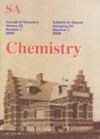The Thermal Agitated Phase Transitions on the Ti32 Nanocluster: a Molecular Dynamics Simulation Study
IF 1
4区 化学
Q4 CHEMISTRY, MULTIDISCIPLINARY
South African Journal of Chemistry-Suid-Afrikaanse Tydskrif Vir Chemie
Pub Date : 2021-01-01
DOI:10.17159/0379-4350/2021/v74a4
引用次数: 1
Abstract
ABSTRACT Molecular dynamics simulations were performed to investigate the stability with respect to increasing the simulated temperature from 300 to 2400 K of an isolated cluster composed of 32 titanium atoms. The interatomic interactions were modelled using Gupta potentials as implemented within the classical molecular dynamics simulation software DL_POLY. The radial distribution functions (RDF), diffusion coefficient, and density profiles were examined to study the structural changes as a function of temperature. It was found that the Ti32 nanocluster exhibits temperature structural transition. The icosahedron and pentagonal bi-pyramid structures were found to be the most dominant building block fragments. Deformation of the nanocluster was also measured by diffusion coefficient, and it was found that the Ti32 are mobile above the bulk melting point. The phase transitions from solid to liquid have been identified by a simple jump in the total energy curve, with the predicted melting temperature near the bulk melting point (1941.15 K). As expected, the RDF's and density profile peaks decrease with increasing temperature. Keywords: Molecular dynamics, titanium cluster, radial distribution functions, diffusion coefficient, mean square displacement.Ti32纳米团簇的热搅拌相变:分子动力学模拟研究
通过分子动力学模拟研究了32个钛原子组成的孤立团簇在300 ~ 2400 K温度范围内的稳定性。原子间相互作用采用经典分子动力学模拟软件DL_POLY中实现的Gupta势进行建模。利用径向分布函数(RDF)、扩散系数和密度分布来研究温度对结构变化的影响。结果表明,Ti32纳米团簇呈现温度结构转变。发现二十面体和五边形双金字塔结构是最主要的积木碎片。通过扩散系数测量了纳米团簇的变形,发现Ti32在体熔点以上是可移动的。在预测熔点(1941.15 K)附近,通过总能量曲线上的一个简单的跳跃可以识别出从固体到液体的相变。正如预期的那样,RDF和密度剖面峰随着温度的升高而降低。关键词:分子动力学,钛簇,径向分布函数,扩散系数,均方位移。
本文章由计算机程序翻译,如有差异,请以英文原文为准。
求助全文
约1分钟内获得全文
求助全文
来源期刊
CiteScore
3.10
自引率
0.00%
发文量
6
审稿时长
>12 weeks
期刊介绍:
Original work in all branches of chemistry is published in the South African Journal of Chemistry. Contributions in English may take the form of papers, short communications, or critical reviews.

 求助内容:
求助内容: 应助结果提醒方式:
应助结果提醒方式:


